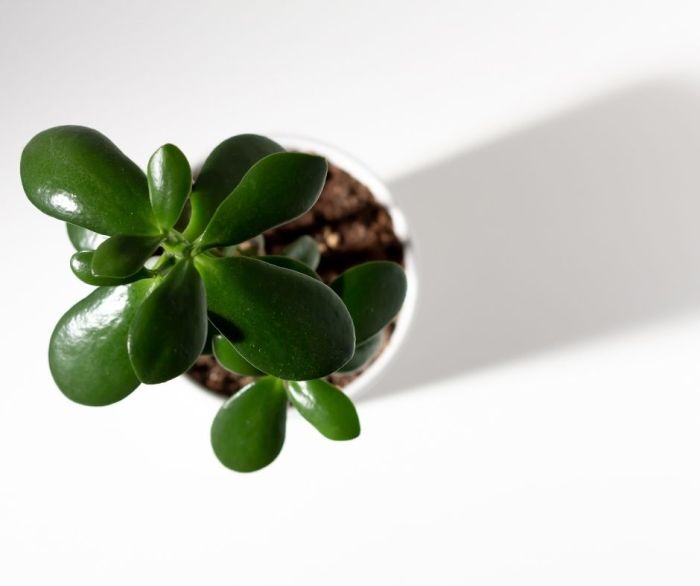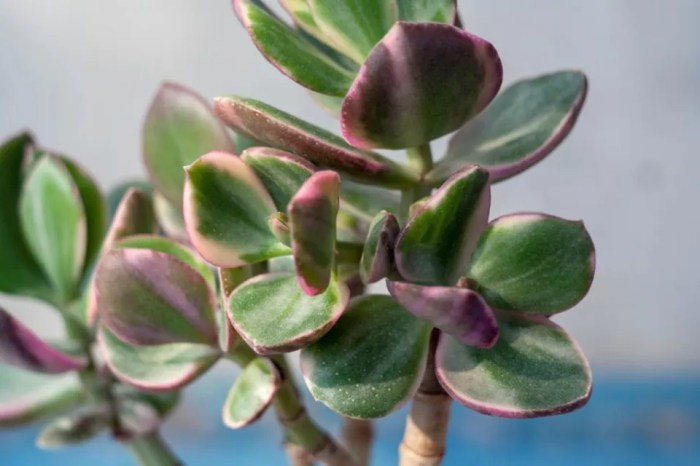How Often Should I Water a Jade Plant?
Understanding Jade Plant Watering Needs

Source: gardenzoo.org
How often should i water a jade plant – Proper watering is crucial for the health and longevity of your jade plant. The frequency depends on several interacting factors, ensuring you understand these will help you avoid common watering mistakes.
Factors Influencing Watering Frequency
Several factors influence how often you need to water your jade plant. These include pot size, soil type, the season, and the climate where your plant resides.
- Pot Size: Smaller pots dry out faster than larger ones, requiring more frequent watering.
- Soil Type: Well-draining soil, like a cactus and succulent mix, dries out quicker than dense, clay-like soil.
- Season: Jade plants require less water during winter dormancy and more during the active growing season of spring and summer.
- Climate: Hot, dry climates will necessitate more frequent watering than cooler, humid environments.
Signs of Underwatering and Overwatering
Recognizing the signs of both underwatering and overwatering is key to maintaining a healthy jade plant.
- Underwatering: Shriveled, wrinkled leaves; leaf drop; dry, brittle soil.
- Overwatering: Soft, mushy leaves; yellowing leaves; leaf drop; foul-smelling soil; root rot (indicated by dark, slimy roots).
Checking Soil Moisture
The finger test is a simple, reliable method for determining soil moisture.
- Insert your index finger about an inch into the soil.
- If the soil feels dry, it’s time to water.
- If the soil feels slightly moist, wait a few more days before watering.
- If the soil feels soggy or wet, the plant is overwatered.
Watering Needs in Different Environments
The table below summarizes the general watering needs of jade plants in various environments. Remember these are guidelines, and actual needs may vary based on the specific conditions.
| Environment | Season | Watering Frequency | Notes |
|---|---|---|---|
| Indoor, Dry Climate | Summer | Every 1-2 weeks | Monitor soil moisture closely. |
| Indoor, Humid Climate | Summer | Every 2-3 weeks | Allow soil to dry out completely between waterings. |
| Outdoor, Dry Climate | Summer | Weekly | Water deeply, ensuring thorough drainage. |
| Outdoor, Humid Climate | Summer | Every 1-2 weeks | Reduce watering frequency during periods of rain. |
Developing a Watering Schedule
A consistent watering schedule is essential for maintaining a healthy jade plant. Adjusting this schedule based on seasonal changes and the plant’s size and growth stage is vital.
Sample Watering Schedule

Source: myprimehome.com
This is a sample schedule; adjust it based on your specific environment and your plant’s needs.
| Season | Watering Frequency | Notes |
|---|---|---|
| Spring | Every 1-2 weeks | Increase watering as growth increases. |
| Summer | Weekly or more frequently | Monitor soil moisture closely; may need more frequent watering in hot, dry conditions. |
| Autumn | Every 2-3 weeks | Gradually reduce watering as growth slows. |
| Winter | Monthly or less | Water only when the soil is completely dry to prevent root rot during dormancy. |
Adjusting Watering Frequency
The size and growth stage of your jade plant significantly impact its watering needs.
- Smaller Plants: Need more frequent watering than larger, established plants.
- Active Growth Stage: Requires more frequent watering than during dormancy.
- Allowing Soil to Dry: Always allow the top inch or two of soil to dry out completely before watering again. This prevents root rot.
Common Watering Mistakes and Solutions
Here are some common mistakes and how to avoid them.
- Overwatering: Allow soil to dry completely between waterings. Improve drainage if needed.
- Underwatering: Water thoroughly when the soil is dry. Consider increasing watering frequency during hot weather.
- Inconsistent Watering: Establish a regular watering schedule and stick to it as closely as possible.
- Using Cold Water: Use room-temperature water to avoid shocking the plant’s roots.
Watering Techniques and Methods
The method you use to water your jade plant can affect its health. Proper technique ensures thorough watering without oversaturation.
Proper Watering Technique
Water thoroughly until water drains from the drainage holes. Avoid getting water on the leaves to prevent fungal diseases. Allow excess water to drain completely; do not let the plant sit in standing water.
Watering Methods
Several methods can be used to water a jade plant, each with its own advantages and disadvantages.
- Top Watering: The most common method; water directly onto the soil surface.
- Bottom Watering: Place the pot in a tray of water and allow the soil to absorb water from the bottom.
- Soaking: Completely submerge the pot in water for a short period to thoroughly saturate the soil.
Watering Pots with and Without Drainage Holes
Drainage holes are crucial for preventing root rot. Pots without drainage holes require more careful watering to prevent overwatering.
- Pots with Drainage Holes: Water thoroughly until water drains from the bottom.
- Pots without Drainage Holes: Water less frequently and only when the soil is almost completely dry. Consider using a pot with drainage holes for better results.
Problems from Improper Watering, How often should i water a jade plant
Improper watering techniques can lead to several issues.
- Root rot
- Leaf drop
- Yellowing leaves
- Stunted growth
- Plant death
Addressing Specific Watering Scenarios
Adjusting your watering approach for specific situations is crucial for maintaining a healthy jade plant. This includes times of stress and during specific life stages.
Watering Stressed Plants
Jade plants under stress (heat or cold) may require adjusted watering.
- Heat Stress: Increase watering frequency, but avoid overwatering.
- Cold Stress: Reduce watering frequency; cold temperatures slow down the plant’s metabolic processes.
Reviving Underwatered or Overwatered Plants
Reviving a jade plant depends on the extent of the problem.
- Underwatered: Gradually reintroduce water, avoiding shocking the plant. Monitor closely for signs of recovery.
- Overwatered: Allow the soil to dry completely. If root rot is suspected, repotting in fresh, dry soil may be necessary.
Newly Potted or Propagated Plants
Newly potted or propagated jade plants have specific watering needs.
- Newly Potted: Water lightly after potting to settle the soil. Wait a few days before watering again to allow the roots to establish themselves.
- Propagated: Water sparingly until roots have developed. Overwatering can easily lead to rot in cuttings.
Watering During Dormancy
Jade plants enter dormancy during winter. Watering needs change significantly during this period.
- Dormancy: Water infrequently, only when the soil is completely dry. Avoid overwatering to prevent root rot.
Visual Aids and Descriptions
Visual cues are important for determining the health and watering needs of your jade plant. Learning to recognize these signs can prevent problems.
Appearance of a Healthy Jade Plant
A healthy, well-watered jade plant has plump, firm leaves with a smooth, slightly waxy texture. The leaves are a vibrant green color, free from blemishes or discoloration.
Visual Indicators of Underwatering and Overwatering
Underwatering and overwatering manifest differently.
- Underwatering: Leaves become shriveled, wrinkled, and may drop. The soil is dry and crumbly.
- Overwatering: Leaves become soft, mushy, and may yellow or brown. The soil is soggy and may have a foul odor. Root rot may be present.
Ideal Soil Conditions
The ideal soil for a jade plant is well-draining, allowing excess water to escape easily. The soil should be slightly moist to the touch, never soggy. A cactus and succulent potting mix is ideal.
Jade plants, known for their resilience, only need watering when their soil is completely dry, typically every 1-2 weeks. This contrasts with the watering needs of other succulents; for example, to understand the differences, consider how often you water a ZZ plant, as explained in this helpful guide: how often do you water a zz plant. Returning to jade plants, infrequent watering prevents root rot and encourages healthy growth.
Proper Watering Technique (Visual Description)
Imagine gently pouring water onto the soil surface, ensuring the water reaches all parts of the pot. Continue pouring until water begins to drain from the drainage holes. Allow the excess water to drain completely, preventing the plant from sitting in standing water. Avoid wetting the leaves as much as possible.
Questions and Answers: How Often Should I Water A Jade Plant
Can I use tap water to water my jade plant?
It’s best to use filtered or distilled water, as tap water may contain minerals that can build up in the soil and harm your plant.
My jade plant’s leaves are dropping. What should I do?
Leaf drop can be a sign of underwatering or overwatering. Check the soil moisture and adjust your watering schedule accordingly. Also consider factors like temperature and light exposure.
How often should I fertilize my jade plant?
Fertilize your jade plant sparingly, only during the growing season (spring and summer), using a balanced, diluted succulent fertilizer.
What type of soil is best for a jade plant?
Well-draining cactus and succulent potting mix is ideal. Avoid heavy, clay-based soils that retain too much moisture.




















